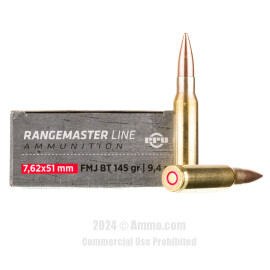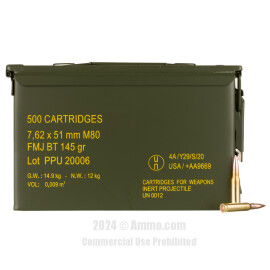
Prvi Partizan Ammo For Sale
History of Prvi Partizan Ammo
Originally called FOMU in 1928, an acronym translating to Weapons and Munitions Factory at Uzice, Prvi Partizan is a Serbian manufacturer of ammunition and hand-loading components. It is the third-largest supplier of ammunition to the American market according to Panjiva.
The Origins of Prvi Ammo
The genesis of Prvi is in 1927. Jakob Posinger, in alliance with the Kingdom of Yugoslavia’s government, purchased machines and began making hunting rifles and ammunition for pistols – first rolling products off the assembly line in May 1928. Originally, the factory was located at Krcagovo’s military barracks. However, a 1935 land gift from the town of Uzice meant a relocation. This was the first privately owned factory in the entire Balkan peninsula.
The brand’s origin is quite historic, as its facilities were heavily damaged by occupying forces during WWII. Partisan military authorities took over, moving the facilities to the underground tunnel safe of the National Bank, and Uzice became the only town in Yugoslavia (and possibly Europe) that had an arms factory under occupation. Although a factory explosion killed more than 120 people during the war, the brand survived and is known for its important role in equipping the National Liberation Army.
FOMU later became known as Prvi Partizan Fabrika (First Partisan Factory) after its role in the Communist-led resistance during WWII, and is based in Uzice, Serbia, to this day. Shooters may notice the headstamp on their cartridges ППУ, which translates to “PPU.” This is an abbreviation of the company’s name in Cyrillic letters.
Prvi Partizan Ammo and the Yugoslav Resistance
The history of the Communist-led – but not dominated – Partisans is quite fascinating and inspiring. Indeed, the Yugoslav Partisans are one of the reasons why the Red Army did not dare to roll their tanks through Yugoslavia and into Albania. The Yugoslav resistance is cited by historians as one of the most effective resistance movements during World War II, alongside the Polish and French resistance. Each of these played a key role in, at the very least, distracting and harassing the Axis powers, forcing them to expend precious resources and retain control of territories theoretically already under their control.
The Yugoslav Partisan movement was the military wing of the Unitary National Liberation Front, ostensibly a Communist-led coalition. This movement’s political wing was known as the Anti-Fascist Council for the National Liberation of Yugoslavia. The Partisan movement’s primary aim was the expulsion of Axis forces from Yugoslavia, however, they also held as a political aim the transformation of the Kingdom of Yugoslavia – effectively a Greater Serbia in everything but name – into a truly federal republic of Southern Slavic peoples.
While the Partisan movement was unabashedly Communist, it was one of the few international Communist parties not firmly under the control of Moscow and Joseph Stalin. Stalin personally banned then-Yugoslav Partisan leader Josip Broz Tito (later Communist dictator of Yugoslavia) from declaring a provisional government in Yugoslavia. The Western Allies, however, gave immediate full support to the Partisans, as they were the only game in town when it came to fighting Axis occupation of the Balkans.
In theory, the Chetniks, Partisans of the Yugoslav government-in-exile, were also fighting the Axis. However, they were not consistent in their opposition to the Axis and would collaborate almost as often as they would oppose. In December 1943, the United States, Britain and the Soviets lined up exclusively behind the Anti-Fascist Council for the National Liberation of Yugoslavia – the Partisans.
In May 1944, the German airborne forces attacked the Partisan headquarters while Tito was in them. Tito then had to flee Yugoslavia, hiding out on an Adriatic island. King Peter agreed to not return to Yugoslavia until a referendum could be held and urged all Yugoslavs to back the Partisans. At this point, the Chetniks effectively became an arm of the Axis, lacking any support among Yugoslavs looking to expel Axis forces from the country. Indeed, the Chetniks did not start organizing resistance to the Axis until several weeks after the Partisans and largely supported the Serbian chauvinism and irredentism the Kingdom of Yugoslavia was well known and often resented for.
In late 1944, the Partisans were 650,000 strong, organized into four field armies and 52 divisions. By April 1945, this number had swelled to 800,000 – making them considerably larger than some of the regular armies part of the Allied coalition.
The Partisans were consistently referred to as “The Partisans,” however, what this was short for was in flux throughout the war:
- National Liberation Partisan Detachments of Yugoslavia (From June 1941 to January 1942)
- National Liberation Partisan and Volunteer Army of Yugoslavia (From January to November 1942)
- National Liberation Army and Partisan Detachments of Yugoslavia (From November 1942 to February 1945)
- Yugoslav Army (On March 1, 1945, the National Liberation Army became the regular armed forces of Yugoslavia)
At the end of the war, Prvi came under state control, as did all major industries in the newly Communist Yugoslavia. Throughout the struggle against the Axis powers, this factory was able to provide ammunition to the Partisan movement, perhaps representing the genesis of the Prvi emphasis on quality. After all, it was constantly a pressing matter of life and death when it came to ammunition working.
British historian Basil Davidson states that by 1943, the Partisans were no longer just a nuisance. They were a serious threat to the Axis forces stationed in the country. He states that throughout the continent, Axis forces were starting to feel the pinch from homegrown resistance forces. However, in Yugoslavia, the casualties were far more than they could afford – and they were firing rounds made at the Prvi factory.
What made the difference between Yugoslav forces and other, similar resistance forces? First of all, they had the only arms plant in occupied Europe. However, a number of Yugoslav Partisan officers had combat experience in the Spanish Civil War, often regarded as the “dress rehearsal” for the Second World War. What helped perhaps just as much was the pan-Yugoslav character of the Partisans. For example, Serbian units could expect support when operating in Croatia and vice versa. This made Partisan units far more mobile in addition to making recruiting easier.
Seven major offensives were undertaken in an effort to stomp out the Yugoslav Partisans, all of which failed to make any inroads against the paramilitary movement. Davidson explains that “It was the nature of Partisan resistance that operations against it must either eliminate it altogether or leave it potentially stronger than before.” After every offensive, the Partisans did emerge stronger than they were before, and he further explains that this was because the Partisans’ political arm successfully convinced the religiously, linguistically and ethnically diverse population of Yugoslavia that this was a war for survival, not simply national liberation.
According to official numbers, the Partisans were 44 percent Serb, 30 percent Croat, 10 percent Slovene, 5 percent Montenegrin, 2.5 percent Macedonian, and 2.5 percent Bosniak. Small but significant numbers of Hungarians and Italians fought in Partisan units.
PPU Ammo Today
Today, Prvi Partizan is one of the largest ammunition manufacturers in the world – producing over 400 types of rifle, pistol, revolver and small arms ammo. While they manufacture ammunition for both civilian and military use, in a wide variety of calibers and loadings, they are also known for producing unusual and rare cartridges – including the 8x56mmR, 7.92x33mm Kurtz, 7.65x53mm Argentine and 8mm Lebel.
Prvi Partizan prides itself on the excellent quality of its ammunition, all manufactured at one factory with three production facilities. It is an anchor of the local economy in the region where it sits. And with three production facilities and over 1,000 workers, it’s no surprise that it has become a provider of superior ammo across the globe. To save even more on your ammunition needs, you can purchase in bulk. For instance, if you're looking for 223 ammo, make sure to check out our bulk 223 ammo page for great prices and deals.
Customer Reviews
-
iolhippie said:
Shot ammo in a Glock 27 Gen 4 with very little problem. Ammo jammed a couple of times, but I don't think the ammo was the problem. I will buy more Prvi Partizan ( PPU) ammo when possible in .40 cal, 9mm, and 357 sig. Great stuff. Shoots cleaner than most other I have found.
-
Boyd said:
Quality Ammunition, fires reliably, good Makarov ammunition for those using less common weapons such as the Makarov or FEG 9 x 18.
-
Mark said:
Recently shot 300 rounds in Walther ppq q5 SF, Canik Tp9SF, Sar9 USA and Ruger PC9 carbine. I had no misfires or FTE problems and the ammo was very accurate. When cleaning guns found little to no residue. I was very impressed and would buy again
-
Alphapredator322 said:
I bought this ammo for my Marlin 1895 after purchasing a different brand of ammo initially for my first range session that I was happy with Accuracy wise for the most part but not so much with the power of the rounds. Well i can tell you that these Prvi rounds performed well across the board, accuracy, quality and big power, which is what I wanted in the rounds I'd be using for this rifle both at the range and in the woods. I try to practice with the same or similar rounds I'd be using when hunting or for self defense. train how you fight is what I was taught. buy these rounds and you wont be disappointed.
-
FHMP said:
Bought a box and they overall worked fine as far as accuracy, but out of every 20-25 bullets one of them does not fire...bummer
-
ed said:
fully satisfied, good value, good price
-
Glen said:
I need all brass to practice at my local indoor range & not much to pick from at an affordable price range so I took a shot with this & it worked perfectly in my Palmetto state armory ak47 with a magpul pmag.
-
Chuck said:
The ammo shoots a tight group, and is very accurate.
-
Mike W Conover, OH said:
I bought one box of this just to try out.. I was shooting it through my LCP, granted I haven't shot much, just one mag, 7 rounds, had one that the primer dented and didnt go off, reloaded it and it fired.. but i still have 40+ rounds to try
-
John said:
Thanks to Serbia for helping the folks in Uzice to manufacture what we need and my friends at ammo.com many thanks to deliver what we need at a decent price. I trust this ammo will perform as expected. Just wishing it was packed in clips ready to fire up.


























